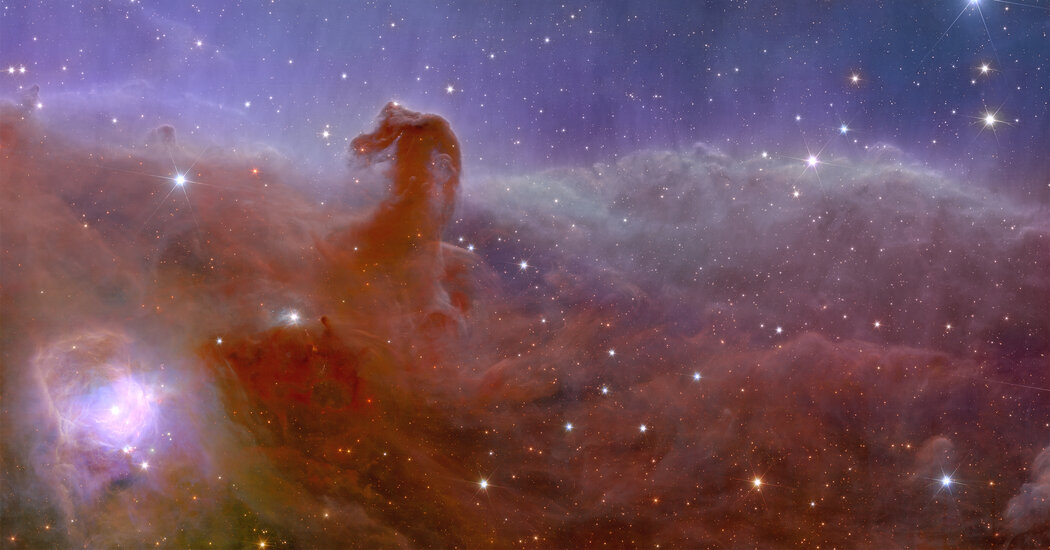Whether or not capturing spiral galaxies or stellar nurseries, Euclid It’s exhibiting off the great aspect of our world.
On Tuesday, the European House Company shared the primary photographs from a robotic telescope in house – 5 ethereal views of our universe.
Launched in July, Euclid seeks to map a 3rd of the extragalactic sky and reveal how the mysterious influences of darkish matter and darkish vitality form the construction of the universe. The brand new photographs are only a glimpse of what scientists count on the house telescope to realize.
“I used to be overwhelmed by the sheer quantity of knowledge,” stated Michael Seifert, a cosmologist at NASA’s Jet Propulsion Laboratory and a member of the Euclid mission. “Having the ability to get actually clear photographs masking a large area on the identical time is actually wonderful.”
Maybe most placing is a shot of the Horsehead Nebula, a star manufacturing facility situated 1,375 light-years from Earth with a particular horse-shaped cloud. The picture reveals reddish-brown gasoline and mud churning with younger stars, younger Jupiter-like worlds, and rogue planets separated from the host star. Within the decrease left nook, large rising stars solid the interstellar clouds of one other nebula, NGC 2023, in a gentle lavender glow.
Scientists additionally launched a shocking new view of the Perseus Cluster, a cluster of galaxies 240 million light-years away. A lot of the colourful spots should not stars, however galaxies, and a few are so faint they’ve by no means been seen earlier than, Dr. Seifert stated. Free-floating stars, stripped from their galaxies and drifting into the areas between them, may additionally be current within the cluster.
The Euclid group additionally shared close-ups of galaxies: a gentle white swirl, IC 342, just like our personal Milky Approach, and an irregular dwarf galaxy, NGC 6822, amid a dense area of stars. The ultimate picture reveals the globular cluster NGC 6397, a set of stars orbiting the disk of our galaxy.
Whereas NASA James Webb Space Telescope By zooming in on one a part of the sky at a time, Euclid excels at depicting massive, however nonetheless detailed, swaths of the universe. That is excellent “whenever you wish to search for a needle in a haystack,” together with issues like free-floating worlds, Dr. Seifert stated.
Utilizing the information that Euclid sends residence, researchers can find out how the net of darkish matter binding our universe collectively impacts the shapes and motions of seen objects in house. The telescope’s detailed decision can be anticipated to assist scientists map the distribution of galaxies over cosmic time, aiding in understanding darkish vitality, the inexplicable pressure that pulls the universe aside.
The mission group is finishing last checks and calibrations of Euclid’s devices, which embrace a 600-megapixel imaging digicam, a near-infrared spectrometer and a photometer that may file mild from galaxies at invisible wavelengths to deduce the gap between them. Over the summer season, scientists labored across the clock to repair the defective navigation sensor that led to the creation of Euclid Pictures of winding star trails Whereas the telescope tried to seize a chunk of the sky.
Scientific observations are scheduled to start early subsequent yr. In 2025, scientists plan to launch the primary Euclid maps of the universe, which can embrace a bigger sky space than all the information collected by NASA so far. Hubble Space TelescopeDr. Seifert stated.
The group expects Euclid to map the sky over the subsequent six years, gathering a set of 12 billion sources for astronomers to mine and uncover.
“The info obtained signify lower than sooner or later of remark,” Dr. Seifert stated of the primary photographs taken by Euclid. “We shall be drowning in information for years and years to come back.”

